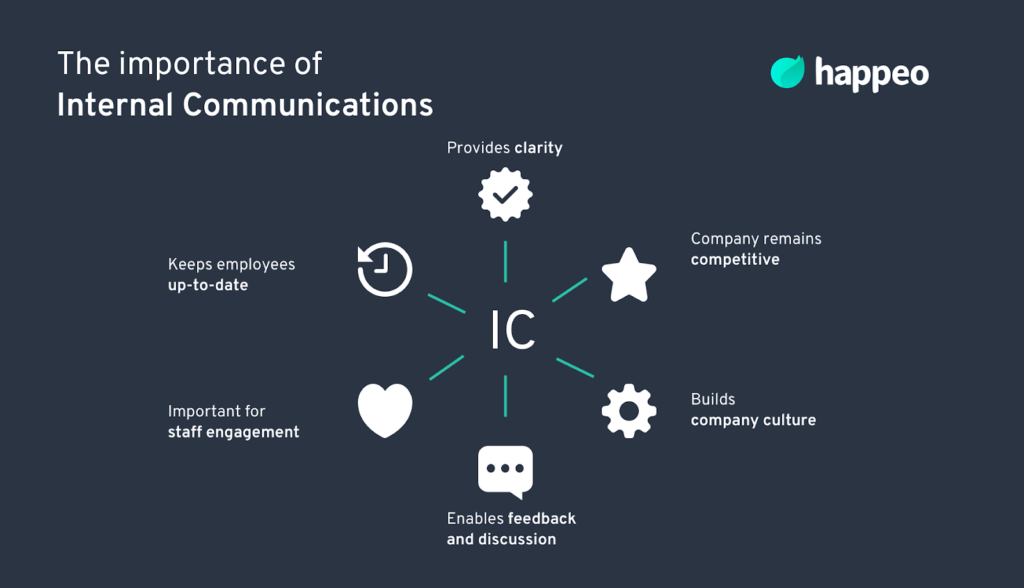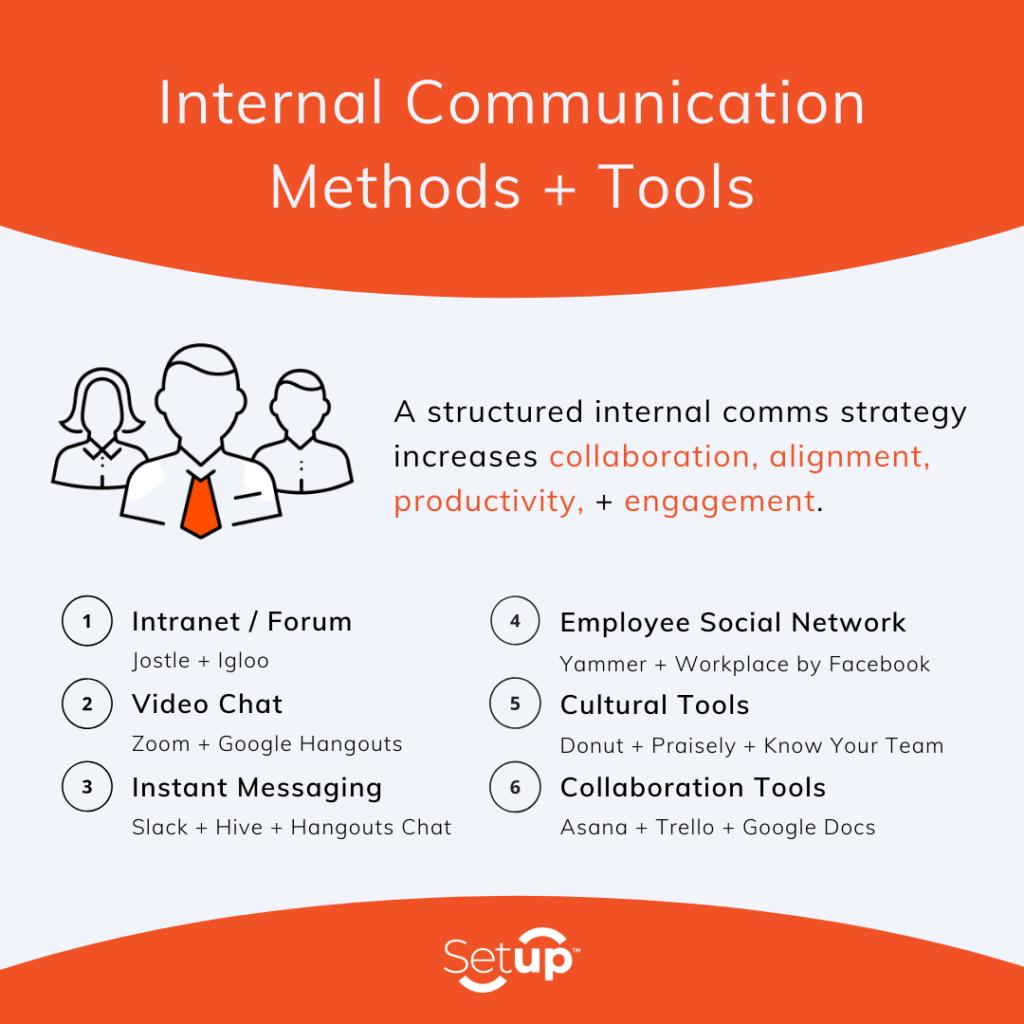10 Tools For Effective Internal Communication
Table of Contents
- Introduction
- 10 tools for internal communication
- Key takeaways
- Conclusion
- FAQs
Working remotely has become a norm post-pandemic, and for many companies, this working style is bound to stay for a long time. Distant roles are becoming increasingly common, and flex offices are sprouting up. Telecommuting presents its own set of obstacles, emphasizing the importance of effective internal communication. In 2021, services and modern tools will essentially replace the void created by not working full-time in a physical workplace.

Internal communication tools can help your firm in the following ways when used together:
- Keep in touch: It’s critical to keep your employees informed and connected via good communication & tools. Organize weekly meetings to keep the team on track and connected with the corporate goals.
- Encourage your workers to participate: It helps individuals feel like they’re part of something bigger than themselves, in which they’ll put their all. However, they must first comprehend the firm’s value and the fact that the company provides them with a source of motivation that is commensurate with it. They become ever more efficient and more in sync with the broader strategy.
- Encourage people to interact socially: Every day at work, you get lunch breaks and many micro contacts with your coworkers that may appear small but are quite vital for employee well-being. That is why it is critical to maintain virtual informal contacts.
- Demonstrate that you’re paying attention to your employees.: It’s critical to know and comprehend your employees’ wants and feelings about the company’s actions. Employees are healthier and more successful when they feel valued and heard.
- Recognize the contributions of your employees: Remote workers may not feel like they’re a part of the team, but their coworkers in the office have more formal and causal connections. It’s critical to prioritize employee recognition. Employees feel more engaged, respected, and valued when they receive regular acknowledgment from peers and management.
Research indicates that the work culture is changing and that both companies and employees must adapt to thrive in the new digital reality. On-site workers went remote overnight, and organizations had to rise quickly to the challenge of sharing information with employees.
Digital internal communication tools like Slack, Zoom, Microsoft Teams, etc., came to the rescue. Let’s take a look at a few internal communication tools that will prove to be a boon for your organization:
10 Tools for Internal Communication

Some of the tools companies today need to have for internal communication include:
1. App for employees on their phones
Yes, a mobile app is necessary these days, especially for businesses with front-line employees who may not have access to a corporate email address or workstation. A branded mobile app will foster a sense of belonging among employees, and push notices will guarantee that everyone has access to the information they require. Mobile has essentially replaced intranets as the primary source of information for your employees—so make sure you’re there!
2. Internal publication
Employees want to read important updates and articles because they don’t always have time to read everything that is sent. This is why having a highly personalized and targeted mailing tool with filtering capabilities is essential. Analytics will also allow you to keep track of what works and what doesn’t, allowing you to fine-tune your approach. It’s critical to get employees used to receive important corporate news regularly that is tailored for them.
3. Employee polls
This is most likely the most effective technique to obtain direct employee input and increase engagement. Your ideal employee survey program should be quick to set up and give top management and local managers equal access to the ability to create surveys. A library of templates can help the process go more smoothly, and it should be anonymous and shareable. It ought to be GDPR compliant, and even a little interactivity (i.e., earning points for engaging) can help to boost interest.
4. Chat for business
A chat component will enable the kind of casual, one-on-one chats that used to happen around water coolers, coffee breaks, and across desks. It should provide a positive user experience, be straightforward so that people aren’t frightened by it, and have security and privacy safeguards to safeguard sensitive data.
5. News stream for the company
A digital newsfeed with the ability to pin important items and categorize audiences by potential and effectiveness department, office, or region is an essential tool. The relevancy of information offered to each user will also be increased by a mix of obligatory and subscription content. The user experience should be clear and easy to use, and it should not rely exclusively on an algorithm to determine the order.
6. A platform for content aggregation
This refers to a platform that incorporates curation tool addons, RSS feeds, social networking feeds, and user-generated content (UGC) (user-generated content). Users and administrators should be able to post, produce, vote on, and share content with a targeted audience. Content is king these days; therefore, having a central information hub is crucial for Internal Communications.
7. Employee recognition, as well as a gamification/rewarding mechanism
This can be any tool or feature that allows you to reward employees for their activities (for example, sharing content), get them interested, connect with other colleagues in a gamified environment, and reward and recognize top performers. A CSR component, such as charitable giving, can also lend significance to the benefits.
8. System for onboarding new employees
Onboarding new workers, introducing them to their coworkers, and providing them with the training they require can be one of the most difficult things to do remotely, so it’s critical to have a robust platform and structure in place. Linkage with an e-learning platform, as well as a collection of training films and seminars they may refer to as needed, can make a major difference.
9. Translation in multiple languages is possible
Your IC will become more globally effective with an automatic translation capability, ensuring that message is understood in any office, everywhere. Employees who aren’t native English speakers will benefit from receiving updated information in their own language, which will boost their sense of belonging inside the organization.
10. The platform for live broadcasting:
Because remote working might reduce the value of face-to-face contacts, a live broadcast option is essential. It has the potential to bridge the gap created by long-distance communication.
Key Takeaways
- Internal communication has a bright future ahead of it
- Put money into the correct digital tools
- Be genuine in your tone
- Make a digital new strategy
- Demonstrate your value to decision-makers
- Give your staff a voice: as culture is key
Conclusion
From the content, we conclude that internal communication results in more engaged employees and, as a result, better workplaces. A philosophy of communicating with library directors enables good organizational communication. Most libraries can emulate most of those communication methods used by NCSU Libraries. Employee commitment increases when messaging is offered to managers in the same way it is promoted to library users. On the other hand, internal communication should not be regarded as a one-way street. Channels of communication should be open in both directions, focusing on possibilities for interaction with senior management.
FAQs
Internal communications software, often known as business messaging software, gives users access to instant messaging platforms that enable direct and group chats within a company. These tools are designed to be simple and convenient, allowing team members to communicate quickly.
Current employees can quickly and simply look through worldwide job listings using modern internal communication platforms. They can also share job openings with eligible persons in their network and on social media to help fill open positions faster.
Seven internal communication tools that work:
1. Intranets and discussion forums are two types of intranets.
2. Signage that is displayed digitally.
3. Tools for instant messaging
4. Collaboration software.
5. Employee social media sites.
6. Tools that help your team bond.
7. Tools for video chatting
Health and safety are essential aspects of inside communication within an organization. When employees begin to return to work, you will send out messages outlining safety precautions and the steps your employees must take.
1. Leadership-Initiated communication is a term used to describe communication in leadership.
2. Employee-Generated Communication is a term that refers to communication that employees generate.
3. Peer-to-peer communication is a type of communication in which two or more people communicate.
4. Communication about a change or a campaign
5. Communication of information
6. Communication between cultures
7. Communication in times of crisis
Latest Blogs
Learn how to rank on AI search engines like ChatGPT, Perplexity, and Gemini by optimizing your content for authority, structure, and relevance. Stay ahead in AI-driven search with this strategic guide.
Explore the best healthcare SEO services for your medical practice. Improve online visibility and effectively reach more patients in need of your services.
Discover top social media agencies specializing in banking solutions, enhancing financial services and driving engagement.
Get your hands on the latest news!
Similar Posts

B2C Marketing
5 mins read
Top Choices for Best Content Marketing Services in B2B Industries

Artificial Intelligence
5 mins read
How A Lead Generation Specialist Can Use AI-Powered Content Funnels to Drive Conversions

Artificial Intelligence
4 mins read